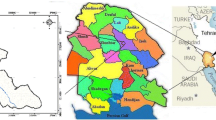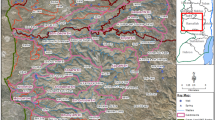Abstract
The arid and semi-arid countries often experience floods due to torrential rainfall events. Appropriate strategy to collect and store rainwater and surface runoff can augment water resources in these countries. In Saudi Arabia, a total of 449 dams with capacity of 2017 million \(\text {m}^{3}\) are available to control floods, recharge aquifers and to supply for domestic and agricultural applications. The southwestern region of the country experiences flash floods, indicating the scope of water resources augmentation through runoff collection. In this study, location of a new dam was identified in Abha, Saudi Arabia, using the watershed modeling system (WMS) software. The WMS software and HEC-HMS hydrologic model were used to delineate watershed and to quantify runoff. The fuzzy rule-based modeling approach was applied to incorporate uncertainty. This study demonstrates that the rainfall events of 25-, 50- and 100-year return periods can generate surface runoff of 10.18 (range 1.77–22.24), 13.08 (range 2.91–26.94) and 16.09 (range 4.25–31.62) million \(\text {m}^{3}\), respectively. Use of runoff from these events can save US$ 0.94–35.4, 1.5–42.8 and 2.3–50.3 million, respectively, which can also reduce \(\text {CO}_{2}\) emission by 24.6–346.9, 40.5–420.3 and 59.1–493.3 million kg, respectively.
Similar content being viewed by others
References
Al-Ahmadi, K.; Al-Ahmadi, S.: Spatiotemporal variations in rainfall-topographic relationships in southwestern Saudi Arabia. Arab. J. Geosci. 7, 3309–3324 (2014)
MOEP (Ministry of Economy and Planning): The Ninth Development Plan (2010–2014), Saudi Arabia (2010)
MOWE (Ministry of Water and Electricity): Annual Report. Riyadh, Saudi Arabia. http://www.mowe.gov.sa/ENIndex.aspx (2014)
MAW (Ministry of Agriculture and Water): Water Atlas of Saudi Arabia, Riyadh, Saudi Arabia (1984)
FAO (Food and Agriculture Organization): Country Report Saudi Arabia. FAO Water Report, vol. 34, pp. 325–327 (2009)
FAO (Food and Agriculture Organization): Proceedings of the Second Expert Consultation on National Water Policy Reform in the Near East, 24–25 November 1997. Cairo, Egypt (1998)
Al-Salamah, I.S.; Ghazaw, Y.M.; Ghumman, A.R.: Groundwater modeling of Saq Aquifer Buraydah Al Qassim for better water management strategies. Environ. Monit. Assess. 173(1–4), 851–860 (2011)
Ouda, O.K.M.: Treated wastewater use in Saudi Arabia: challenges and initiatives. Int. J. Water Resour. Dev. 32(5), 799–809 (2016)
MOWE (Ministry of Water and Electricity): Annual Report. Riyadh, Saudi Arabia. http://www.mowe.gov.sa/ENIndex.aspx (2017)
SWCC (Saline Water Conversion Corporation): http://www.swcc.gov.sa/english/AboutSWCC/Pages/About.aspx. Accessed 09 Apr 2017
SWCC (Saline Water Conversion Corporation): Annual Report, 2015. Riyadh, Saudi Arabia (2015)
ECRA (Electricity & Cogeneration Regulatory Authority): Annual Statistical Booklet for Electricity and Seawater Desalination Industries, 2014, Saudi Arabia (2014)
MOWE (Ministry of Water and Electricity): Annual Report. Riyadh, Saudi Arabia. http://www.mowe.gov.sa/ENIndex.aspx (2013)
Al-Zahrani, M.; Chowdhury, S.; Abo-Monasar, A.: Augmentation of surface water sources from spatially distributed rainfall in Saudi Arabia. J. Water Reuse Desalination 5(3), 391–406 (2015)
Missimer, T.M.; Drewes, J.E.; Amy, G.; Maliva, R.G.; Keller, S.: Restoration of wadi aquifers by artificial recharge with treated wastewater. Groundwater 50(4), 514–527 (2012)
Al Maktoumi, A.: The effect of the Al-Khod Dam on the subsurface soil properties: infiltration and recharge efficiency. Water Res. Centre Bull. (2013)
Al-Turbak, A.S.; Al-Muttair, F.F.: Evaluation of dams as a recharge method. Int. J. Water Resour. Dev. 5(2), 119–124 (1989)
Lopez, O.; Stenchikov, G.; Missimer, T.M.: Water management during climate change using aquifer storage and recovery of stormwater in a dunefield in western Saudi Arabia. Environ. Res. Lett. 9(7), 075008 (2014)
Missimer, T.M.; Guo, W.; Maliva, R.G.; Rosas, J.; Jadoon, K.Z.: Enhancement of wadi recharge using dams coupled with aquifer storage and recovery wells. Environ. Earth Sci. 73, 7723–7731 (2014)
Al-Othman, A.A.: Enhancing groundwater recharge in arid region—a case study from central Saudi Arabia. Sci. Res. Essays 6(13), 2757–2762 (2011)
Afshari, S.; Tavakoly, A.A.; Rajib, A.; Zheng, X.; Follum, M.L.; Omranian, E.; Fekete, B.: Comparison of new generation low-complexity flood inundation mapping tools with a hydrodynamic model. J. Hydrol. 556, 539–556 (2017)
Al-Shareef, O.H.; Ezzeldin, M.; Gutub, S.A.: Comparison of peak discharge estimation methods in northern Jeddah in western Saudi Arabia. Adv. Appl. Fluid Mech. 14(2), 219–242 (2013)
Ewea, H.A.S.A.: Hydrological analysis of flooding wastewater lake in Jeddah, Saudi Arabia. Meteorol. Environ. Arid Land Agric. Sci. 21(1), 125–144 (2010)
Sharif, H.O.; Al-Juaidi, F.H.; Al-Othman, A.; Al-Dousary, I.; Fadda, E.; Jamal-Uddeen, S.; Elhassan, A.: Flood hazards in an urbanizing water shed in Riyadh, Saudi Arabia. Geomat. Nat. Hazards Risk 7(2), 702–720 (2014)
Al-Yamani, M.S.: Hydraulic response of Wadi Fatimah basin, western province, Kingdom of Saudi Arabia. Arab Gulf J. Sci. Res. 22(3), 157–164 (2004)
Masoud, M.H.: Geoinformatics application for assessing the morphometric characteristics’ effect on hydrological response at watershed (case study of Wadi Qanunah, Saudi Arabia). Arab. J. Geosci. 9(4), 1–22 (2016)
Mallick, J.: Geospatial-based soil variability and hydrological zones of Abha semi-arid mountainous watershed, Saudi Arabia. Arab. J. Geosci. 9, 281 (2016)
Subyani, A.M.: Geostatistical study of annual and seasonal mean rainfall patterns in southwest Saudi Arabia. Hydrol. Sci. J. 49(5), 803–817 (2004)
Furl, C.; Sharif, H.O.; Al-Zahrani, M.; Hassan, A.E.; Mazari, N.: Precipitation amount and intensity trends across southwest Saudi Arabia. J. Am. Water Resour. Assoc. 50(1), 74–82 (2014)
Al-Zahrani, K.H.: Sustainable development of agriculture and water resources in the kingdom of Saudi Arabia. Conf. Int. J. Arts Sci. 1(17), 3–37 (2009)
Areeq, A.; Chowdhury, S.; Al-Zahrani, M.: Uncertainty in depth-duration relationships: implications on rainfall intensity-duration-frequency (IDF) curves and runoff quantification (under review) (2016)
USDA (United States Department of Agriculture): Technical Report of Urban Hydrology for Small Watersheds (TR-55). Washington, DC (1986)
USGS, United States Geological Survey. https://lta.cr.usgs.gov/SRTM1Arc (2016). Accessed 30 May 2016
IIASA (International Institute for Applied Systems Analysis): Harmonized World Soil Database. FAO, IIASA (2009)
Aquaveo: http://www.xmswiki.com/wiki/WebServiceCatalog (2016a). Accessed 10 May 2017
Aquaveo: http://www.aquaveo.com/software/wms-watershed-modeling-system-introduction (2016b). Accessed 6 May 2016
Aquaveo: http://www.xmswiki.com/wiki/WMS:TOPAZ (2016c). Accessed 31 May 2016
HEC-HMS: Technical Reference Manual. US Army Corps of Engineering Center, Arlington (2009)
Khadam, I.M.; Kaluarachchi, J.J.: Multi-criteria decision analysis with probabilistic risk assessment for the management of contaminated ground water. Environ. Impact Assess. Rev. 23, 683–721 (2003)
Ferson, S.: What Monte Carlo methods cannot do? Hum. Ecol. Risk Assess. 2, 990–1007 (1996)
Guyonnet, D.; Come, B.; Perrochet, P.; Parriaux, A.: Comparing two methods for addressing uncertainty in risk assessments. J. Environ. Eng. 125, 660–667 (1999)
Chowdhury, S.; Champagne, P.; Husain, T.: Fuzzy risk-based decision-making approach for selection of drinking water disinfectants. J. Water Supply Res. Technol. AQUA 56(2), 75–93 (2007)
Chowdhury, S.; Champagne, P.; McLellan, P.J.: Uncertainty characterization approaches for risk assessment of DBPs in drinking water: a review. J. Environ. Manag. 90(5), 1680–1691 (2009)
Zimmermann, H.J.: Fuzzy Set Theory-and Its Applications, 4th edn. Kluwer Academic Publishers, Norwell (2001)
Chen, S.J.; Hwang, C.L.: Fuzzy Multiple Attribute Decision Making-Methods and Applications. Springer, Berlin (1992)
Klir, G.J.; Yuan, B.: Fuzzy Sets and Fuzzy Logic-Theory and Applications. Prentice-Hall, Englewood Cliffs (1995)
Xiong, L.; Shamseldin, A.Y.; O’Connor, K.M.: A non-linear combination of the forecasts of rainfall-runoff models by the first-order Takagi–Sugeno fuzzy system. J. Hydrol. 245, 196–217 (2001)
Shrestha, B.P.; Duckstein, L.; Stakhiv, E.Z.: Fuzzy rule-based modeling of reservoir operation. J. Water Resour. Plan. Manag. 122, 262–269 (1996)
Freer, J.E.; McMillan, H.; McDonnell, J.J.; Beven, K.J.: Constraining dynamic TOPMODEL responses for imprecise water table information using fuzzy rule based performance measures. J. Hydrol. 291, 254–277 (2014)
Rashetnia, S.: Flood vulnerability assessment by applying a fuzzy logic method: a case study from Melbourne. Doctoral dissertation, Victoria University (2016)
Lee, H.M.: Applying fuzzy set theory to evaluate the rate of aggregative risk in software development. Fuzzy Sets Syst. 79, 323–336 (1996)
UPMD (The Town of University Park). http://www.upmd.org/docs/11-749-1427932598.PDF. Accessed 11 Apr 2016
Chowdhury, S.; Al-Zahrani, M.: Reuse of treated wastewater in Saudi Arabia: an assessment framework. J. Water Reuse Desalination 3, 297–314 (2013)
Kalantari, N.; Rangzan, K.; Thigale, S.S.; Rahimi, M.H.: Site selection and cost-benefit analysis for artificial recharge in the Baghmalek plain, Khuzestan Province, southwest Iran. Hydrogeol. J. 18(3), 761–773 (2010)
ESCWA (Economic and Social Commission for Western Asia): Role of desalination in addressing water scarcity. ESCWA Water Development Report 3. New York, United Nations (2009)
Kally, E.; Fishelson, G.: Water and Peace: Water Resources and the Arab-Israeli Peace Process. Praeger, New York (1993)
Zhou, Y.; Tol, R.S.: Evaluating the costs of desalination and water transport. Water Resour. Res. 41(3) (2005)
Darwish, M.A.: Desalting fuel energy cost in Kuwait in view of $75/barrel oil price. Desalination 208, 306–320 (2006)
Alrehaili, A.M.; Hussein, M.T.: Use of remote sensing, GIS and groundwater monitoring to estimate artificial groundwater recharge in Riyadh, Saudi Arabia. Arab. J. Geosci. 5(6), 1367–1377 (2012)
Mohamed, H.I.; Ahmed, S.S.: Assessment of hydraulic performance of groundwater recharge techniques. Int. J. Water Resour. Arid Environ. 2(3), 120–124 (2013)
Acknowledgements
The author(s) would like to acknowledge the support provided by the Deanship of Scientific Research (DSR) at King Fahd University of Petroleum and Minerals (KFUPM) for funding this work through Project No. RG 1410-1 & 2
Author information
Authors and Affiliations
Corresponding author
Rights and permissions
About this article
Cite this article
Chowdhury, S., Fahmi, M.I. Fuzzy Rule-Based Assessment of Runoff for Abha, Saudi Arabia, Using the Watershed Modeling System (WMS) Software. Arab J Sci Eng 43, 5457–5468 (2018). https://doi.org/10.1007/s13369-018-3177-3
Received:
Accepted:
Published:
Issue Date:
DOI: https://doi.org/10.1007/s13369-018-3177-3




